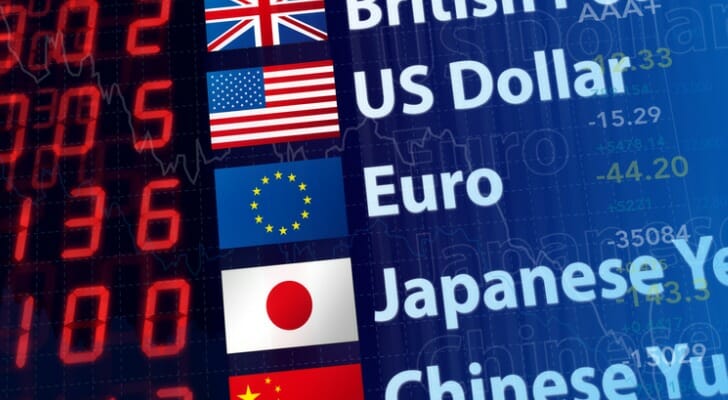The value of money is always changing. Currency in one country on one day reflects the specific economic health of that place at that time. Depending on the country, fluctuations can be small or wildly different from day to day or week to week. If you’re doing business internationally, you need to be concerned with the economic risk of the companies you work with, along with the exchange rate risk that may come. A financial advisor can help you prepare for all financial situations, including creating strategies to help you avoid these types of risks.
What Is Exchange Rate Risk?
Exchange rate risk is the possible direct loss in the value of cash or assets due to changes in currency values between nations. Also known as currency risk, exchange rate risk deals with international transactions where a business or investor with one currency risks losing money if the exchange rate changes while buying or selling an asset in a different currency.
Here’s a simple example: You live in the U.S. and you want to buy a home in England. The home costs £400,000. When you sign the purchase agreement to pay £400,000, every U.S. Dollar equates to 1.25 Sterling. So, for the £400,000 house, you’re paying $500,000.
However, if in between you signing the purchase agreement and you closing on the home, the Sterling strengthens to be £1.50 for every dollar, you’re now paying $600,000 – $100,000 more. While this is a simplification of exchange rate risk, this is exactly what businesses and investors must be prepared for when working internationally.
How Is Exchange Rate Risk Measured?
One way exchange rate risk is measured is through what’s called a value-at-risk calculation (VaR). This calculation relies on three parameters:
- The currency being used.
- The length of time the position on the investment will be held.
- The amount of confidence in the estimation of risk.
To calculate the VaR, you use one of three models for the estimation of risk: historical, variance-covariance or Monte Carlo. The historical model uses data from the past to arrive to an estimation of risk. The variance-covariance model applies an equation that comes up with a linear distribution for the estimation of risk. The Monte Carlo is similar to the variance-covariance model, but it furthers it to create a random simulation to estimate risk.
This can be extremely complex to calculate and follow. However, when a lot of cash is at stake, it’s crucial to know how much risk is being taken. While that’s how exchange rate risk is estimated and measured, let’s talk about how companies and investors can hedge against it.
How Companies Hedge Against Exchange Rate Risk

With knowledge of exchange rate risk, you need to have some tools or strategies to address it and help you manage that risk effectively. The best strategy might depend on what the risk is and how much money you’re trying to protect. Here are a few ways businesses that work internationally deal with it regularly.
- Forward Contracts: A forward contract is where two parties agree to buy or sell at a specific amount and at a specific time. This contract also allows the parties to lock in the exchange rate between the currencies involved. These types of contracts typically last anywhere between a couple weeks to a year.
- Options: Options are similar to forwarding contracts in that it’s two parties agreeing on a rate and price at a certain time. However, they differ in that they give the business or investor the option to buy or sell, whereas forward contracts require it. Options don’t come free – to buy an option, you have to pay a premium. You’ll be out that premium if you choose not to exercise the option.
- Currency Swaps: Businesses in countries with different currencies can use a currency swap to hedge exchange rate risk. At its most basic form, a currency swap is two companies agreeing to trade an agreed-upon amount in each respective currency. For example, an American company may agree with an English company to swap $1 million for £750,000.
What Exchange Rate Risk Means for Individual Investors
What the risk of fluctuating exchange rates means for individual investors depends on the investor and the investment. Are you making a large, one-time investment in a piece of international real estate? You may want to consider using a forward contract to buy the currency to buy the property at a set price.
Are you looking to diversify your portfolio with specific international stocks? It may be worthwhile to keep some of the foreign currency in a foreign bank account. Otherwise, you could accept the risk as part of the changing market, and try to plan your buying/selling around favorable exchange rates. A diverse portfolio with some international assets may be enough of a hedge. Still, know that you’re risking more without accounting for exchange rate risk.
The Bottom Line

For those making transactions abroad, exchange rate risk can be a real concern. A sudden shift in currency value can eat into your profits. Measuring exchange rate risk is a complex process with variables and models to consider. You can reduce risk in your international investments using derivatives like forward contracts and options. For smaller investors, portfolio diversification is a must, and can also help hedge against foreign exchange risk.
Tips for Investing
- Talking with a financial advisor can help you understand your risks, including exchange rate risk. SmartAsset’s free tool matches you with up to three financial advisors who serve your area, and you can interview your advisor matches at no cost to decide which one is right for you. If you’re ready to find an advisor who can help you achieve your financial goals, get started now.
- Want to tailor your asset allocations to how risk tolerant you are? We’ve got a calculator for that. Check out SmartAsset’s asset allocation calculator to select the portfolio that’s right for you and see the breakdown of what types of assets you should invest in.
©iStock.com/Edwin Tan, ©iStock.com/narvikk, ©iStock.com/3D_generator
